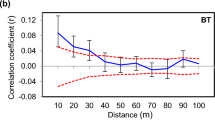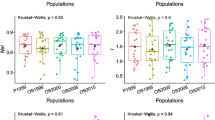Abstract
Different conservation measures including domestication approaches are needed to preserve rare and extensively used plant species and to satisfy future market demands. Snow lotus (a common name used for a number of high altitude species in central Asia) species in Mongolia are important medicinal plants, mostly endangered at the regional level due to the extensive use for medicinal purposes and naturally limited distribution ranges. In order to develop effective conservation and cultivation approaches we studied the morphological and genetic diversity as well as the seed germination behavior of three populations of Saussurea involucrata in the Altay Mountains of Western Mongolia. Plant height and leaf length were measured on 41–53 randomly selected individuals in each population. Enhancement of seed germination was studied using either mechanical or chemical scarification with potassium nitrate and gibberellic acid. Genetic diversity within and among three populations of the species was analyzed using Amplified Fragment Length Polymorphisms. Plants in three populations differed in height and leaf length (P < 0.001). Plant size tended to be negatively correlated with habitat altitude. Seed germination rate was low and increased with seed soaking in gibberellic acid. However, the response of seeds to different treatments was rather population-specific. Most treatments did not significantly affect mean days to germination and the ratio of shoot to root dry weight of 2-weeks old seedlings. The level of genetic diversity in the studied populations was lower than the average value for other long-lived perennial herbs. Analysis of molecular variance revealed a high differentiation within populations (92 % of total variation) indicating sufficient gene flow among populations.


Similar content being viewed by others
References
Dariimaa S (2014) Flora of Mongolia (Asteraceae: Cichorioideae and Carduoideae), vol 14A. Bembi san, Ulaanbaatar, pp 174–175
Eyre-Walker A, Gaut RL, Hilton H, Feldman DL, Gaut BS (1998) Investigation of the bottleneck leading to the domestication of maize. Proc Natl Acad Sci USA 95:4441–4446
Frankham R (2005) Genetics and extinction. Biol Conserv 126:131–140
Gailite A, Ievinsh G, Rungis D (2011) Genetic diversity analysis of Latvian and Estonian Saussurea esthonica populations. Environ Exp Biol 9:115–119
Google Earth 7.1.5.1557 (2015) Image landsat borders and labels data layer. http://www.kh.google.com. Accessed 18 June 2015
Jeong JH, Lee BC, Yoo KO, Jang SK, Kim ZS (2012) Influence of small-scale habitat patchiness on the genetic diversity of the Korean endemic species Saussurea chabyoungsanica (Asteraceae). Biochem Syst Ecol 43:14–24
Ligaa U (2013) Saussurea involucrata. In: Shiirevdamba Ts (ed) Mongolian red book. Admon, Ulaanbaatar, pp 434–435
Ligaa U, Ninjil N, Davaadorj T, Erdenetuya N (2015) Medicinal plants of Mongolia and their usage in western and eastern medicine. Imunal, Ulaanbaatar, pp 85–86
Lowe AJ, Boshier D, Ward M, Bacles CFE, Navarro C (2005) Genetic resource impacts of habitat loss and degradation; reconciling empirical evidence and predicted theory for neotropical trees. Heredity 95:255–273
Nyambayar D, Oyuntsetseg B, Tungalag R, Jamsram T, Sanchir C, Backman S, Soninkhishid N, Gombobaatarr S, Baillie JEM, Tsendeekhuu T (eds) (2011) Mongolian red list and conservation action plans of plants (Part 1), Regional Red List Series 9, Zoological Society of London. National University of Mongolia, Ulaanbaatar, p 72
Nybom H (2004) Comparison of different nuclear DNA markers for estimating intraspecific genetic diversity in plants. Mol Ecol 13:1143–1155
Peakall R, Smouse PE (2006) GENALEX 6: genetic analysis in Excel. Population genetic software for teaching and research. Mol Ecol Notes 6:288–295
Peakall R, Smouse PE (2012) GenAlEx 6.5: genetic analysis in Excel. Population genetic software for teaching and research-an update. Bioinformatics 28:2537–2539
R Core Team (2015) R: a language and environment for statistical computing. R Foundation for Statistical Computing, Vienna, Austria. http://www.R-project.org
Sharma RK, Sharma S, Sharma S (2006) Seed germination behaviour of some medicinal plants of Lahaul and Spiti cold desert (Himachal Pradesh): implications for conservation and cultivation. Curr Sci India 90(8):1113–1118
Shi Z, von Raab-Straube E (2011) Saussurea Candolle. In: Wu ZY, Raven PH (eds) Flora of China 20–21. Science and Missouri Botanical Garden, Beijing, p 72
Tan DY, Dai PF (2011) Floral biological characteristics of Saussurea involucrata in relation to ecological adaptation. Chin J Plant Ecol 35(01):56–65
Templeton AR, Robertson RJ, Brisson J, Strasburg J (2001) Disrupting evolutionary processes: the effect of habitat fragmentation on collared lizards in the Missouri Ozarks. Proc Natl Acad Sci USA 98(10):5426–5432
Urgamal M, Oyuntsetseg B, Nyambayar D, Dulamsuren Ch (2014) Conspectus of the vascular plants of Mongolia. Admon, Ulaanbaatar, pp 219–221
Vos P, Hogers R, Bleeker M, Reijans M, van de Lee T, Hornes M, Friters A, Pot J, Peleman J, Kuiper M, Zabeau M (1995) AFLP: a new technique for DNA fingerprinting. Nucleic Acids Res 23(21):4407–4414
Watkins TJ, Cantliffe DJ (1983) Mechanical resistance of the seed coat and endosperm during germination of Capsicum annuum at low temperature. Plant Physiol 72:146–150
Yeh FC, Yang RC, Boyle T (1999) POPGENE. Microsoft Windows-based freeware for population genetic analysis. Release 1.31, University of Alberta, Edmonton, Alberta, Canada. https://www.ualberta.ca/~fyeh/popgene_download.html
Acknowledgments
The study was conducted within the WaterCope project, a Mongolian-Sino-German Research and Development cooperation project aiming at developing and implementing improved management strategies for water resource management and land use in the transborder water tower area of Altay-Dzungaria in Mongolia and China (www.watercope.org). WaterCope is funded by the International Fund for Agricultural Development (IFAD Funding Number: I-R-1284-WATERCOPE). The authors are thankful for technical help by the staff of the Department of Forest Genetics and Forest Tree Breeding, Georg-August-Universität Göttingen, Germany, especially to Mrs. A. Dolynska and to Mr. R. Braukmann, the master gardener of the Greenhouse for Tropical Crops, Universität Kassel. Thanks also to Dr. U. Bayarsaikhan from National University of Mongolia for producing the map of sampling area.
Author information
Authors and Affiliations
Corresponding author
Rights and permissions
About this article
Cite this article
Dashzeveg, N., Buerkert, A. & Wiehle, M. Morphological and genetic diversity and seed germination behavior of a snow lotus (Saussurea involucrata, Asteraceae) from the Mongolian Altay Mountains, Western Mongolia. Genet Resour Crop Evol 64, 927–934 (2017). https://doi.org/10.1007/s10722-016-0412-1
Received:
Accepted:
Published:
Issue Date:
DOI: https://doi.org/10.1007/s10722-016-0412-1




